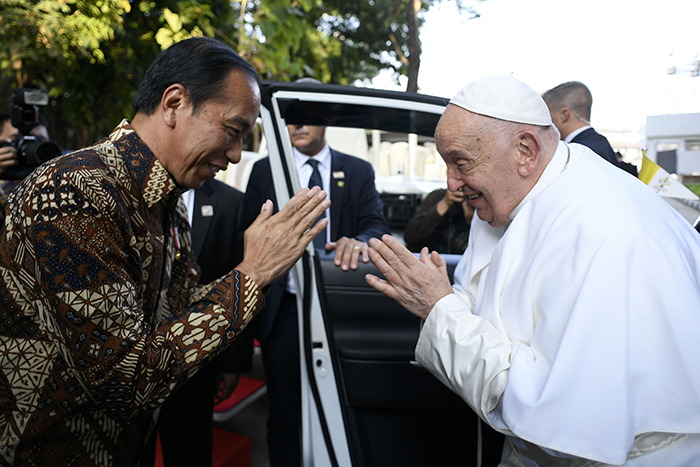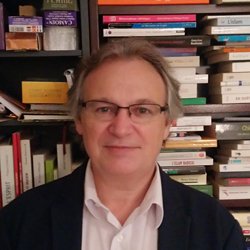Entretiens / Geopolitical Observatory of Religion
5 September 2024
Pope Francis’ Visit to South-East Asia: A Symbol of Interfaith Dialogue Strengthening?

On September 3rd, Pope Francis began a long visit to four countries in Southeast Asia, starting with Indonesia, the world’s largest Muslim country. He will then visit East Timor, a predominantly Catholic country that gained independence from Indonesia after a 24-year conflict in 1999, Papua New Guinea, also a Christian country, and Singapore, a country with a great religious diversity. This region, a bridge between Asia and Oceania, has become increasingly important in recent years as a result of the economic and strategic development of the Indo-Pacific region, and is characterised both by relatively harmonious religious coexistence and by a number of recent (East Timor) or ongoing (Indonesian Papua) conflicts. What are the Pope’s objectives for this visit? What role does the region play in Vatican diplomacy, which is characterised by inter-religious dialogue? François Mabille, Associate Research Fellow at IRIS and director of the Observatoire géopolitique du religieux, provides some answers.
On September 3rd, Pope Francis began the longest visit of his pontificate to Southeast Asia (Indonesia, East Timor, Papua New Guinea and Singapore). What is at stake in this visit, and to what extent does the geopolitical context in which it is taking place differ from the visits of previous popes?
Following in the footsteps of Paul VI and John Paul II, Pope Francis is now visiting South-East Asia, on a trip that is longer than those of his predecessors and also marked by different themes. Broadly speaking, Paul VI’s trip took place in the context of decolonisation, which was already well underway. For the Catholic Church, the aim was to show an interest in the young local Churches and in different cultures. Almost 20 years later, in 1989, John Paul II’s visit was dominated by East Timor’s desire for independence, a desire championed by a bishop, Bishop Bello. He was criticised by the Holy See, which felt that this bishop, who a few years later would receive the Nobel Peace Prize, had no business meddling in politics. The other subject of concern at the time was the margin of religious freedom allowed to Catholic missionaries. The Pope’s current visit takes place in a completely different context. In geopolitical terms, Asia now occupies a major place; Indonesia is trying to make its unique voice heard on the international stage, seeking, in the wake of the non-alignment of yesteryear, to be a bridge between the West and Asia; for his part, the Pope has placed the themes of the ‘peripheries’ and the encounter (dialogue) at the heart of his global pastoral work. For him, the notion of periphery replaces the older notion of ‘confines’ in Catholic thought: it refers to geographical peripheries – South-East Asia is a long way from Rome – as well as existential peripheries, i.e. exclusion in all its forms, hence the meetings with specific associations working on this issue. Finally, dialogue concerns two major issues: working for peace, notably with other religions and more specifically with Muslim political and religious leaders; and commitment to the environment, as the Pope is constantly seeking to mobilise Catholics and ‘people of goodwill’ around this major issue.
What is the Vatican’s relationship with the countries of the Asia-Pacific region, where Catholicism is still generally in the minority? What interest does the region hold for the Holy See?
The overall perspective of the Holy See remains Catholic universalism, i.e. the evangelisation of all peoples. This missionary dimension can no longer be carried out in the same way as in the past, and one of the challenges, of course, is to dissociate the idea that Catholicism is assimilated to the West, in other words, that it is perceived as a Western religious trend, and therefore under a foreign influence. This work now involves an attitude of respect for different local cultures (since the 1970s, the Catholic term has been inculturation; sociologists prefer to talk about acculturation processes) and the emergence of local Catholic Churches. The fact that Pope Francis has appointed a cardinal of Papuan origin is indicative of this development, and at the same time of the process of internationalisation of the Catholic Church. But this challenge of inculturation and representation is sometimes undermined by the very active proselytism of certain evangelical Protestant churches, which is perceived as aggressive. One of the underlying challenges of Francis’ visit, as was the case a year ago in Mongolia, is also to succeed in dissociating Catholicism from Protestantism, in the representations of both governments and populations.
Par ailleurs, la situation religieuse dans les quatre pays visités est fort différente : une majorité musulmane en Indonésie, chrétienne en Papouasie-Nouvelle-Guinée, catholique au Timor oriental, un « melting pot » à Singapour. Dans ce contexte, la question de la liberté religieuse en tant que minorité se pose à certaines Églises catholiques locales, et plus largement, le problème de la coexistence et de la tolérance entre acteurs religieux. Et ce, dans des cadres politiques fort divers avec lesquels le Saint-Siège et les Églises locales doivent composer : la régulation des religions en Indonésie ne s’effectue pas de la même manière qu’à Timor ou à Singapour.
Pope Francis has made the issue of inter-religious dialogue and, more broadly, the promotion of a policy of tolerance, one of the highlights of his visit. What role do these two issues play in Vatican diplomacy? What action has been taken on this issue on the international stage?
Since the 1960s (the Second Vatican Council in the history of contemporary Catholicism), a major effort has been made to deepen inter-religious dialogue between Catholicism and other religions. John Paul II introduced a first inflection point in 1986, when he brought together all the religious players in Assisi to mobilise them in favour of peace, in a way anticipating the approach that Huntington would later develop. Subsequently, the Holy See’s diplomatic efforts were strongly opposed to the foreign policy of Bush (son) and thus to the US war against Iraq. At the same time, the difficulties of religious freedom for Christians in many countries, particularly Muslim countries, came to light. Since the beginning of his pontificate, Pope Francis has sought to deepen relations with Muslim political and religious leaders, in order to achieve a common approach based on respect and tolerance. This work, carried out during the Pope’s many trips to Muslim countries, and which is also based on developments within Islam itself, has led, for example, to the document on ‘human brotherhood’ signed in 2019 with the Grand Imam of Al-Azar. Indonesia is the largest Muslim country, recognises religions and regulates them too, and above all has developed a specific foreign policy around interfaith dialogue, both for domestic reasons and to position itself on the international stage. There is therefore a possible and interesting convergence here for the policy of tolerance promoted by the Holy See. In East Timor, during the celebration of the country’s independence, the Parliament adopted the document on ‘human brotherhood’ mentioned above. Finally, Singapore’s religious policy is also unique and is regularly reviewed. It is therefore in a variety of political contexts, but all confronted with the presence of numerous religious identities, that the Pope will speak and try to promote his approach to a policy of tolerance.
Translated by Deepl

